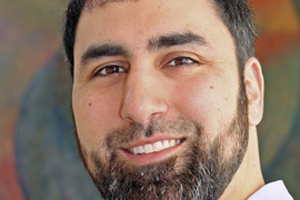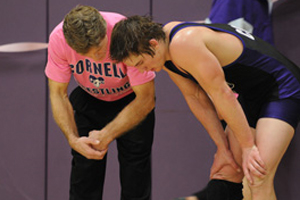P.E. reinvented as kinesiology
In the past seven years there have been some big changes in the kinesiology department—not least of which is its new name.
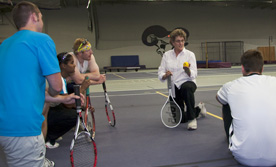
Before the 2006–07 school year the department was still called physical education. But even before that things had started to change. At the beginning of the 2003–04 school year, two professors, Ellen Whale and Steve DeVries, made the move from coaching and teaching to teaching full time. The rest of the staff moved to coaching full time. It was a good move, DeVries said, since he and Whale were already headed in that direction. It left the coaching staff free to focus more on recruiting and training, while he and Whale were able to chart a course for the department.
Right now, there are three faculty members in the department, DeVries, Whale and Jennifer Fagenbaum. They split duties, with Whale teaching most of the education prep courses, DeVries handling the psychology of sports and exercise, and Fagenbaum—the newest faculty member—working with the scientific end.
Because of that split, and the new courses the department has been able to offer, they’ve seen more students taking their courses. Before the 1997–98 school year, all students had to take a course on Lifetime Physical Fitness. Once that requirement was eliminated, the department could have been marginalized. But with expanded course offerings, kinesiology professors are attracting students from many other majors.
That, DeVries said, along with the recent addition of Fagenbaum, allows the department to offer more depth, including independent study courses that let students set their own direction. Fagenbaum started as an adjunct in 2007–08, became visiting professor in 2008–09, and was hired onto the tenure track in 2009– 10. DeVries came to Cornell in 1983 and Whale started in 1978.
“Exercise science was the missing piece,” he said. “We just have more to offer now.”
There was a time when a physical education major meant just that: you were prepared to teach physical education. But because of the growth in the field of kinesiology, there are many more options now. Kinesiology majors—there are 66 this year, up from 57 in 2007-08—can teach or coach, of course, but they also can go into occupational or physical therapy, sports management, or any number of health-related fields. (See “Where are they now” for a look at what Cornell’s physical education/ kinesiology graduates are doing.)
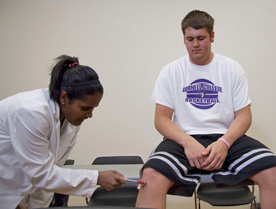
Part of the way the department can train students for diverse fields lies in another relatively new addition: the exercise physiology lab in the basement of the Small Multi-Sport Center. There, in what used to be a racquetball court, is a space that serves double duty: as both a classroom and a hands-on lab.
The lab holds thousands of dollars of equipment, including equipment to measure heart rate, respiration, volume of blood being pumped from the heart, and other ways the body reacts to exercise. From there, students can learn what muscles are being used in a given exercise and can recommend the right intensity of exercise for someone.
There are more traditional teaching tools, too, like calipers that help determine composition (fat percentage, lean body mass including muscle and bone mass), and several skeletons and other anatomical models used in anatomy courses. But for those anatomy courses, Fagenbaum also
uses software programs to simulate parts of the human body. The biology department also lets students view the cadaver in West Science, she said, but the computer program means they have more chances to understand how the human body works.
The lab has been open for two years now, and the faculty is still refining how it’s being used and seeing what else they need to offer.
“We keep adding more every year,” she said.
Those additions keep up with the changes in kinesiology as a discipline, and enrollment has increased in part because of the interdisciplinary nature of the courses they teach.
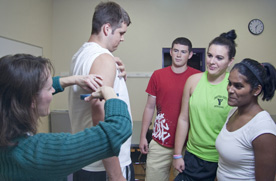
Fagenbaum said she occasionally sees biology majors and pre-med students in her exercise science courses. The students are either interested in sports and physical activity generally, she said, or are considering working with physical and occupational therapy when they graduate. Her classes, which focus on how the body moves in exercise, among other things, show them something they can’t get in other departments.
DeVries said that his Sport Psychology and Sport in American Society classes attract not just kinesiology majors, but psychology and sociology students. His Exercise Psychology course has generated interest as well. The psychology of exercise is important, he said, because people understand why they should exercise, but many don’t, and the course examines the reasons why.
The focus on interdisciplinary studies has helped kinesiology majors, Whale said, because if students are interested in sports medicine or another allied health field, they have resources on campus with Dimensions: The Center for the Science and Culture of Healthcare. Some students even participate in Operation Walk, where they observe medical professionals performing joint replacement surgeries, and they assist with physical therapy in countries like China, El Salvador, and Vietnam.
And that growth has been thanks to the split that happened seven years ago.
“I’m not aware of any small college anywhere else with a kinesiology program that isn’t involved in coaching,” Whale said. “Teaching is all we do; it’s our focus.”

